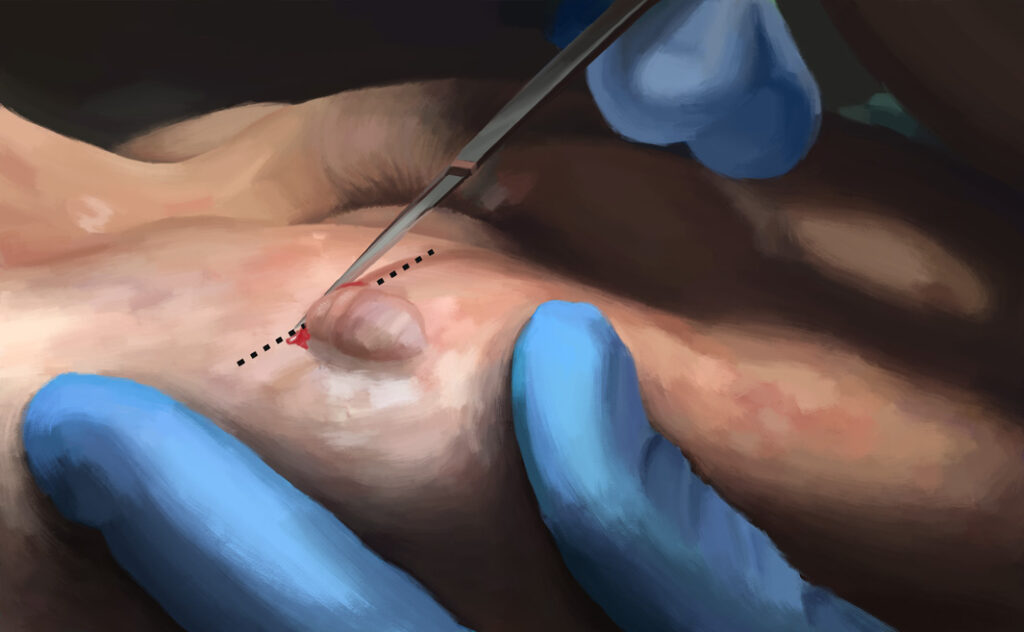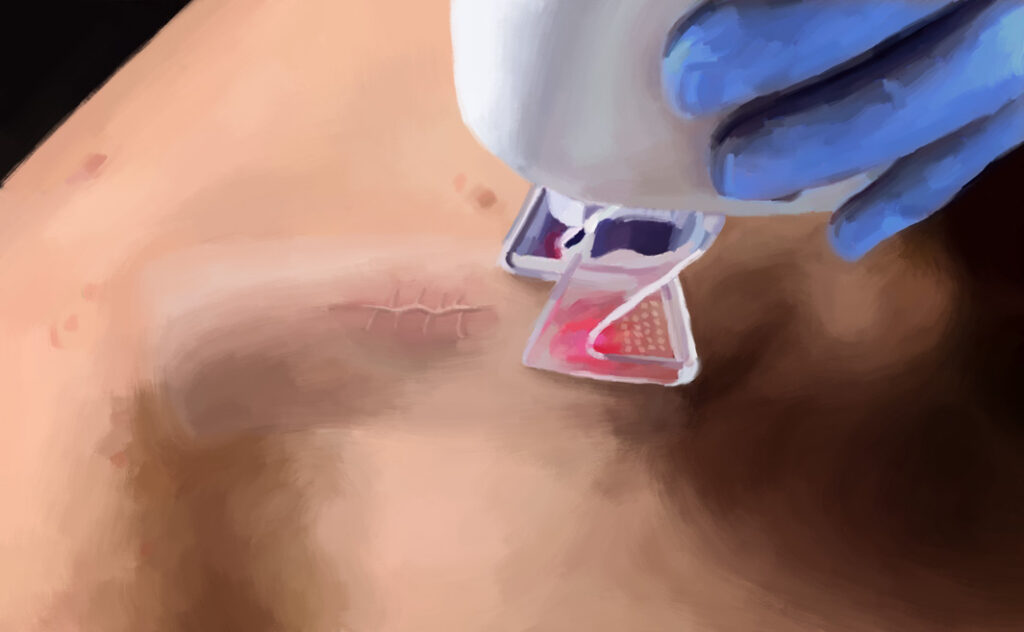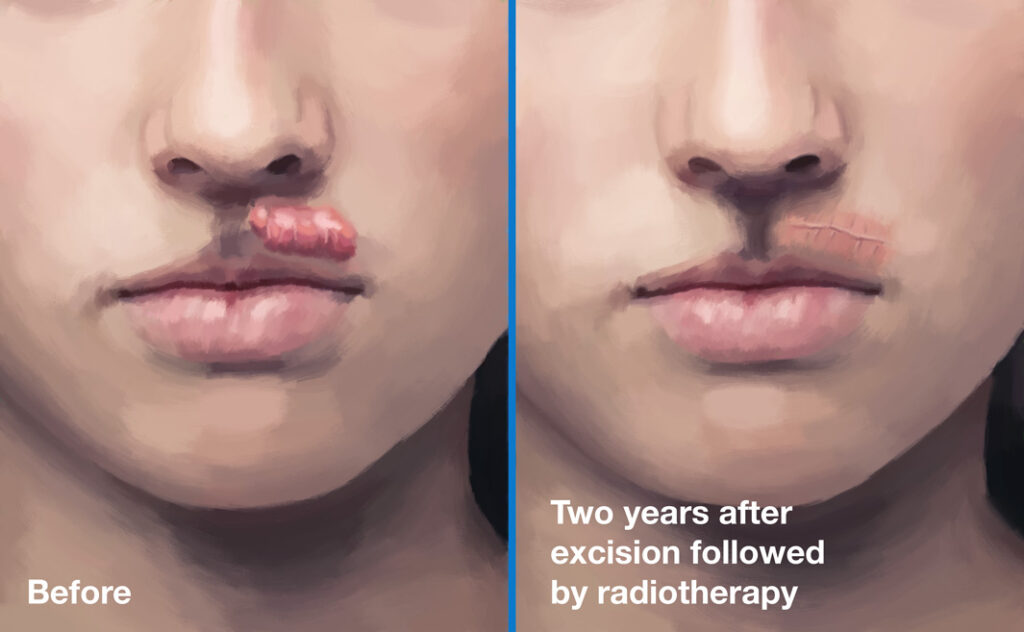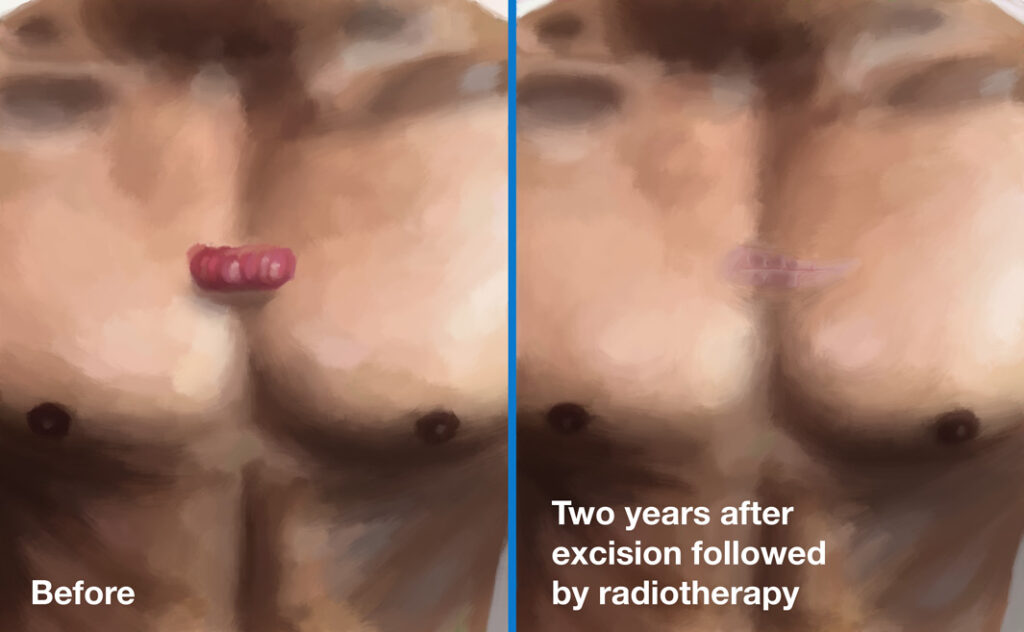Excision and radiotherapy is a two-pronged approach to treating keloid acne scars. The treatment consists of two steps:
- Excision (cutting out the scar): In excision, the keloid scar is surgically removed under local anesthesia. The doctor uses a scalpel to remove one scar at a time. The edges of the wound are sutured (sewn together) after the procedure, leaving behind a smaller, linear scar.
- Radiotherapy (administering radiation to the site): Keloid scars are likely to re-grow if treated with excision alone. Therefore, doctors follow excision up with radiation within a few days to prevent keloid re-growth.1,2
As with all scar repair treatments, excision and radiotherapy are sometimes combined with other scar repair procedures to achieve desired results.
People with active acne should not undergo acne scar repair of any kind, including excision and radiotherapy. Be sure that your skin is clear of acne before beginning scar treatment.
Since excision is a serious procedure that requires skill and experience, it is important to find a skilled doctor with extensive experience specifically in treating acne scars with this technique.
*CAUTION. The use of radiotherapy for treating raised scars remains limited because of concerns that radiotherapy may potentially cause long-term consequences, like skin cancer at the treated location. While there is no direct evidence that radiotherapy of scars causes cancer, this treatment should be approached with caution, particularly in the case of young patients.2
Before agreeing to undergo excision and radiotherapy, consult multiple doctors about their opinions, proposed treatments, expected outcomes, and prices.
Procedure details:
The first step of excision and radiotherapy treatment is the surgical removal of the scar, which is called excision.
Excision begins with these steps:
- Marking the scar(s): The doctor uses a marker to indicate the scars to be removed
- Cleaning the skin: The skin is cleaned with povidone-iodine
- Numbing the skin: The doctor injects the skin with a local anesthetic. About 10-15 minutes later, the skin becomes sufficiently numb and the blood vessels in the skin decrease in diameter, ensuring minimal bleeding during the procedure.
In excision, a scalpel is used to cut out the raised scar. Then, the edges of the wound are sewn together.1,3

Radiotherapy: Keloid scars that are surgically removed without radiotherapy have a 45% to 100% probability of re-growing.1 To prevent re-growth, doctors administer radiotherapy within the first 3 days, and sometimes within hours, after excision. Studies show that this is the time when radiotherapy is most effective.2,3

Radiotherapy works by killing off fibroblasts (skin cells that produce collagen) at the scar site. Since raised scars result from too much collagen buildup, decreasing the number of fibroblasts in the skin reduces the likelihood that these scars will re-grow after excision.1,4
Radiotherapy can be given on different schedules and in different amounts:
- Radiation schedules: Most doctors administer a single dose (session) of radiation per day over 1-3 days, but in some cases, radiotherapy may continue for as long as 12 days.
- Radiation amounts: The amount of radiation is measured in units called Gy (gray). Typically, a patient receives a total amount of 10-30 Gy after excision.5-11
Anesthesia:
Excision requires anesthesia and the doctor will numb the skin with:
Local anesthesia: The doctor injects an anesthetic into the skin prior to the procedure.5
Radiotherapy: No anesthesia is needed before radiotherapy.
Before-and-after:

A keloid scar before (left) and 2 years after (right) excision followed by radiotherapy.

A keloid scar before (left) and 2 years after (right) excision followed by radiotherapy.
References
- Berman B, and Bieley HC. Adjunct therapies to surgical management of keloids. Dermatol Surg. 22(2), 126-30 (1996).
- Lee JW, Seol KH. Adjuvant Radiotherapy after Surgical Excision in Keloids. Medicina (Kaunas). 57(7), 730 (2021).
- Miles OJ, Zhou J, Paleri S, Fua T, Ramakrishnan A. Chest keloids: effect of surgical excision and adjuvant radiotherapy on recurrence, a systematic review and meta-analysis. ANZ J Surg. 91(6), 1104-09 (2021).
- Levy LL, and Zeichner JA. Management of acne scarring, part II. A comparative review of non-laser-based, minimally invasive approaches. Am J Clin Dermatol. 13(5), 331-340 (2012).
- Ogawa R, et al. Postoperative radiation protocol for keloids and hypertrophic scars: statistical analysis of 370 sites followed for over 18 months. Ann Plast Surg. 59(6), 688-91 (2007).
- Klumpar DI, Murray JC, and Anscher M. Keloids treated with excision followed by radiation therapy. J Am Acad Dermatol. 31(2 Pt 1), 225-31 (1994).
- Kovalic JJ, and Perez CA. Radiation therapy following keloidectomy: a 20-year experience. Int J Radiat Oncol Biol Phys. 17(1), 77-80 (1989).
- Ogawa R, Mitsuhashi K, Hyakusoku H, and Miyashita T.Postoperative electron-beam irradiation therapy for keloids and hypertrophic scars: retrospective study of 147 cases followed for more than 18 months. Plast Reconstr Surg. 111(2), 547-53; discussion 554-5 (2003).
- Lo TC, Seckel BR, Salzman FA, and Wright KA. Single-dose electron beam irradiation in treatment and prevention of keloids and hypertrophic scars. Radiother Oncol. 19(3), 267-72 (1990).
- Enhamre A, Hammar H. Treatment of keloids with excision and postoperative X-ray irradiation. Dermatologica. 167(2), 90-3 (1983).
- Ogawa R, Tosa M, Dohi T, Akaishi S, Kuribayashi S. Surgical excision and postoperative radiotherapy for keloids. Scars Burn Heal. 5, 2059513119891113 (2019).
 Acne.org Products
Acne.org Products